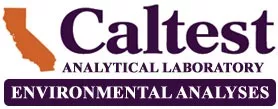Pyrethroid Analysis Methods
Click here for current compound list, RLs, and MDLs
Pyrethroid Pesticide Analysis by Negative Chemical Ionization Gas Chromatography with Mass Spectrometer Detector operated in the Selected Ion Monitoring mode
(NCI GCMS SIM)
This NCI GCMS SIM technique allows us to achieve about ten times better sensitivity with increased selectivity compared to previous methods. At present we have extract cleanup steps that have proven helpful in tests of wastewater treatment plant effluent spiked at low levels. We offer this information as a progress report on the state of the method development. If you choose to send samples in for analyses we ask that you supply at least two additional one liter bottles for matrix spike and matrix spike duplicate sample volumes to help us trend the method’s performance in matrix.
Brief Summary
Approximately one Liter of sample is extracted, sample extract is passed through multiple step clean up, and brought to final volume.
Instrumentation is GCMS run in the NCI mode using Selected Ion Monitoring. The method is based on that of Neil Robinson of Syngenta, Analytical Method for the Determination of Synthetic Pyrethroids in Sediment by Gas Chromatography-Negative Chemical Ionization Mass Spectrometry. 2006
Analytical system is calibrated from 0.5 ng/L to 50 ng/L. All analyses are accompanied by Method Blank, Laboratory Control Sample (LCS) and Matrix Spike and Matrix Spike Duplicates (MS and MSD). It is important in collection of samples to provide two additional one liter bottles for the Matrix Spike and Spike duplicates, (total of three liters required, four if an extra volume is provided in case of the need for sample re-extraction).
System sensitivity check standards are run at mid point calibration and at the lowest calibration standard of 0.5 ng/L to verify that dirty samples have not degraded system sensitivity.
Limitations
Note: Permethrin is about 10x less sensitive by NCI than the other pyrethroid analytes. Fenvalerate and Esfenvalerate are indistinguishable by this approach and are co-reported. Tralomethrin and Deltamethrin are also co-reported. MDL values can change as MDL studies are performed. Please check with lab if the date referenced on the list is older than one year.
Sample Preservation and Storage
The containers used for sampling and storage should be glass or Teflon and have screw caps with Teflon. All samples and extracts should be stored at not frozen to 6 degrees C.
Aqueous Samples should be extracted within 14 days of sampling, with the exception of Cyhalothrin and Permethrin which shows lack of stability after 3 days (per USGS and CA Department of Food and Ag). Use of 20 ml/L of ‘keeper solvent’ can extend hold time in waters to 7 days per Southern Illinois University study. Soils can be frozen to extend the stability time to 6 months per USGS.
Difference between GC/MS SIM EI (Electron Impact ionization) and GC/MS SIM NCI (Negative Chemical Ionization)
How does this differ from the previous method? The former approach met EPA method 8270 criteria, and was in conformance to MDL and Reporting Limit derivation criteria. However the method was at it’s limit with respect to sensitivity. It could not reach the low ng/L and sub ng/L reporting limits required as toxicology studies indicated were necessary. The switch to NCI from EI improved sensitivity about 10x.
